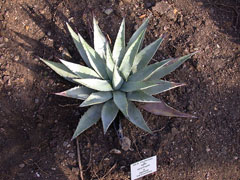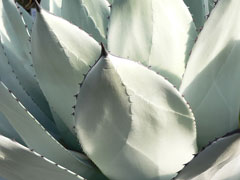 |
|
http://commons.wikimedia.org/wiki/User:Keith_Edkins |
 |
| http://commons.wikimedia.org/wiki/User:BS_Thurner_Hof |
Translate this page:
Summary
The Agave genus, belonging to the Asparagus family (Asparagaceae), includes various species such as Goldenflower Agave, Desert Agave, Palmer’s Agave, Parry’s Agave, and Utah Agave. These plants are historically significant as food sources for Native Americans, who consumed their caudices (crowns, heads, or hearts), flower stalks, flower buds, flowers, and seeds. While these parts are edible, extensive preparation is needed to reduce saponins and irritating soap-like compounds in all of the agave—traditional preparation involves baking the parts in fire pits, enhancing their flavour and texture. The crowns and flower stalks are the most valuable, often baked and consumed immediately or stored for later use. Agave syrup can also be made from the baked crowns.
Agave flowers and seeds are generally not suitable for consumption due to their acrid taste and the presence of potentially harmful compounds. Dislodging agave plants and removing their leaves is labour-intensive, requiring tools like a sharp axe. Agave blooms in late spring to early summer, and its flowers, while not ideal for human consumption, play an essential role in the ecosystem, supporting wildlife. Some agave species are protected, and their collection may be restricted to ensure conservation [2-3].
Physical Characteristics

 Agave parryi is an evergreen Perennial growing to 0.5 m (1ft 8in) by 1 m (3ft 3in) at a slow rate.
Agave parryi is an evergreen Perennial growing to 0.5 m (1ft 8in) by 1 m (3ft 3in) at a slow rate.
See above for USDA hardiness. It is hardy to UK zone 8 and is not frost tender. It is in leaf all year. The species is hermaphrodite (has both male and female organs) and is pollinated by Moths, bats.
Suitable for: light (sandy) and medium (loamy) soils and prefers well-drained soil. Suitable pH: mildly acid, neutral and basic (mildly alkaline) soils. It cannot grow in the shade. It prefers dry or moist soil and can tolerate drought.
UK Hardiness Map
US Hardiness Map
Synonyms
Plant Habitats
Cultivated Beds; South Wall. By.
Edible Uses
Edible Parts: Leaves Sap Seed Stem
Edible Uses:
The heart of the plant is very rich in saccharine matter and can be eaten when baked[2, 105]. Sweet and nutritious, but rather fibrous[213]. It is partly below ground[85]. Seed - ground into a flour and used as a thickener in soups or used with cereal flours when making bread[92]. Young flower stalk - raw or cooked[257]. It was generally roasted[177, 183]. Tender young leaves - roasted[161]. Sap from the cut flowering stems is used as a syrup[177]. Nectar from the flowering stems is made into a sweet syrup[183]. The sap can also be tapped by boring a hole into the middle of the plant at the base of the flowering stem[213]. It can be fermented into 'Mescal', a very potent alcoholic drink[213]. Parts Used: Caudices (crowns, heads, or hearts), flower stalks, flower buds, flowers, and seeds. Preparation: Extensive preparation is often required. Cooking reduces saponins (irritating soap-like compounds). Harvesting: Crowns can be gathered anytime, traditionally, when flower stalks emerge. Flower stalks are best gathered when they first appear (April to June), while still soft. Traditional Method: Native Americans baked agave flower stalks and crowns in fire pits overnight. Baked parts can be consumed immediately or stored for future use. Agave syrup is made by boiling baked crowns with water [2-3].
References More on Edible Uses
Medicinal Uses
Plants For A Future can not take any responsibility for any adverse effects from the use of plants. Always seek advice from a professional before using a plant medicinally.
Antiseptic Diuretic Laxative Miscellany
The sap is antiseptic, diuretic and laxative[21].
References More on Medicinal Uses
The Bookshop: Edible Plant Books
Our Latest books on Perennial Plants For Food Forests and Permaculture Gardens in paperback or digital formats.

Edible Tropical Plants
Food Forest Plants for Hotter Conditions: 250+ Plants For Tropical Food Forests & Permaculture Gardens.
More

Edible Temperate Plants
Plants for Your Food Forest: 500 Plants for Temperate Food Forests & Permaculture Gardens.
More

More Books
PFAF have eight books available in paperback and digital formats. Browse the shop for more information.
Shop Now
Other Uses
Fibre Miscellany Needles Paper Pins Soap Thatching
The leaves contain saponins and an extract of them can be used as a soap[2]. It is best obtained by chopping up the leaves and then simmering them in water - do not boil for too long or this will start to break down the saponins[K]. A very strong fibre obtained from the leaves is used for making rope, coarse fabrics etc[2, 61, 92]. A paper can also be made from the fibre in the leaves[2]. The thorns on the leaves are used as pins and needles[2]. The dried flowering stems are used as a waterproof thatch[2] and as a razor strop[89].
Special Uses
Carbon Farming
References More on Other Uses
Cultivation details
Historic Crop Management: Standard Staple Crop: Basic Starch
Landscape Uses:Border, Container, Foundation, Ground cover, Massing, Rock garden, Specimen. Requires a very well-drained soil and a sunny position[1, 200]. This species is probably the hardiest member of the genus, it survives outdoors grown against a warm wall at Kew[11]. In the wild, plants often experience snow during the winter with temperatures as low as -18°c for short periods[181]. A monocarpic species, the plant lives for a number of years without flowering but dies once it does flower. However, it normally produces plenty of suckers during its life and these take about 10 - 15 years in a warm climate, considerably longer in colder ones, before flowering[11]. This plant is widely used by the native people in its wild habitat, it has a wide range of uses. Members of this genus are rarely if ever troubled by browsing deer[233]. Special Features:Attracts birds, Attractive foliage, North American native, All or parts of this plant are poisonous, Flowers are rare, Attractive flowers or blooms. Bloom Time: Late spring to early summer. Wildlife: Flowers are better left for wildlife as they contain acrid compounds, making them unpalatable for human consumption. Environmental Impact: Some species are protected, so gathering may be restricted in certain areas [2-3]. Challenges: Dislodging an agave is difficult and requires tools like a sharp axe. Preparation: Removing leaves to access crowns is challenging due to their toughness and spines [2-3].
Carbon Farming
-
Historic Crop
These crops were once cultivated but have been abandoned. The reasons for abandonment may include colonization, genocide, market pressures, the arrival of superior crops from elsewhere, and so forth.
-
Management: Standard
Plants grow to their standard height. Harvest fruit, seeds, or other products. Non-Destructive management systems.
-
Staple Crop: Basic Starch
The Carbon Farming Solution. Eric Toensmeier.
References Carbon Farming Information and Carbon Sequestration Information
Temperature Converter
Type a value in the Celsius field to convert the value to Fahrenheit:
Fahrenheit:
The PFAF Bookshop
Plants For A Future have a number of books available in paperback and digital form. Book titles include Edible Plants, Edible Perennials, Edible Trees,Edible Shrubs, Woodland Gardening, and Temperate Food Forest Plants. Our new book is Food Forest Plants For Hotter Conditions (Tropical and Sub-Tropical).
Shop Now
Plant Propagation
Seed - surface sow in a light position, April in a warm greenhouse. The seed usually germinates in 1 - 3 months at 20°c[133]. Prick out the seedlings into individual pots of well-drained soil when they are large enough to handle and grow them on in a sunny position in the greenhouse until they are at least 20cm tall. Plant out in late spring or early summer, after the last expected frosts, and give some protection from the cold for at least their first few winters[K]. Offsets can be potted up at any time they are available. Keep in a warm greenhouse until they are well established[200].
Other Names
If available other names are mentioned here
Native Plant Search
Search over 900 plants ideal for food forests and permaculture gardens. Filter to search native plants to your area. The plants selected are the plants in our book 'Plants For Your Food Forest: 500 Plants for Temperate Food Forests and Permaculture Gardens, as well as plants chosen for our forthcoming related books for Tropical/Hot Wet Climates and Mediterranean/Hot Dry Climates. Native Plant Search
Found In
Countries where the plant has been found are listed here if the information is available
Weed Potential
Right plant wrong place. We are currently updating this section.
Please note that a plant may be invasive in one area but may not in your area so it’s worth checking.
Conservation Status
IUCN Red List of Threatened Plants Status :

Growth: S = slow M = medium F = fast. Soil: L = light (sandy) M = medium H = heavy (clay). pH: A = acid N = neutral B = basic (alkaline). Shade: F = full shade S = semi-shade N = no shade. Moisture: D = dry M = Moist We = wet Wa = water.

Expert comment
Author
Engelm.
Botanical References
11200270
Links / References
For a list of references used on this page please go here
Readers comment
© 2010, Plants For A Future. Plants For A Future is a charitable company limited by guarantee, registered in England and Wales. Charity No. 1057719, Company No. 3204567.